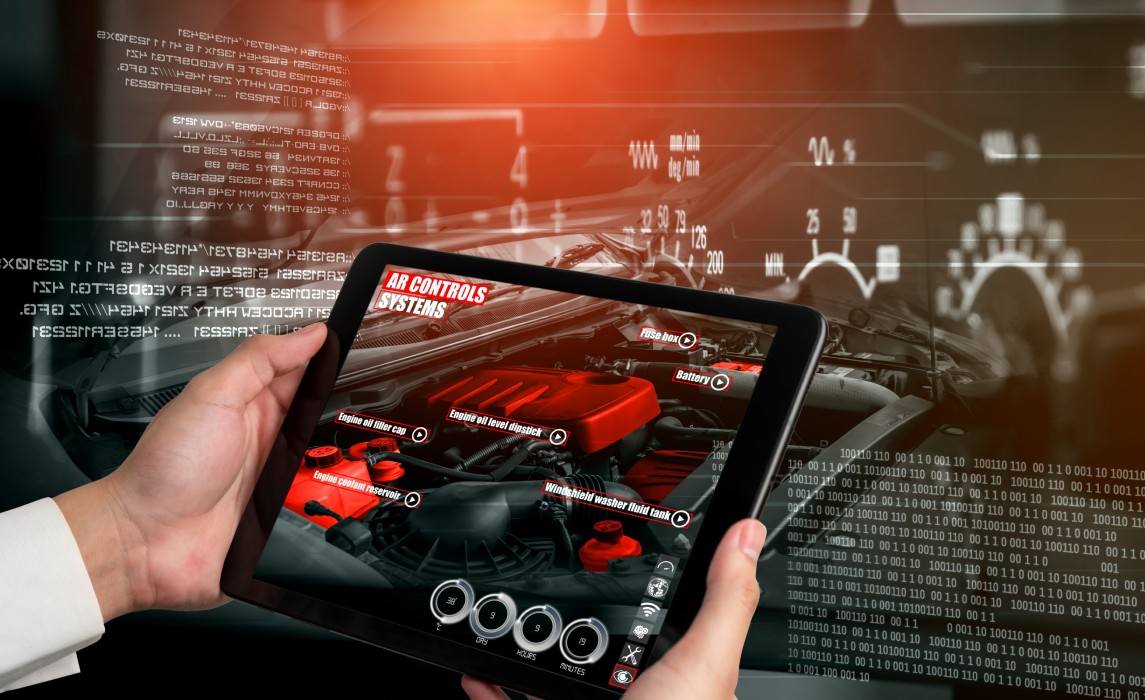Introduction

The automotive industry stands at a pivotal moment in its history, experiencing an unprecedented transformation that fundamentally changes how vehicles are conceptualized, developed, tested, and validated. This transformation is centered around virtual automobile development and is completely redefining the entire automotive development lifecycle. The complexity of modern vehicles has reached extraordinary levels, with contemporary instrument clusters running multiple applications, involving hundreds of screens, and increasingly sophisticated human-machine interfaces (HMI) that must perform flawlessly across numerous vehicle variants and use cases.
The traditional automotive development cycle, which typically spans 3-5 years from initial concept to production, faces mounting pressure from rapid technological advancement and market demands. This pressure is particularly acute in the realm of software-defined vehicles, advanced driver assistance systems (ADAS), and connected vehicle technologies, where innovation cycles are measured in months rather than years. The acceleration of development timelines necessitates a fundamental reimagining of automotive development and validation processes, challenging long-held industry practices and assumptions.
Virtual development: The imperative and current scenario

Modern development teams, often comprising 500-600 developers working concurrently on various features and systems, have outgrown traditional hardware-dependent development approaches. Perhaps more significantly, this approach enables rigorous testing regimes, resulting in substantial improvements in product quality and reliability.
The modern vehicle HMI ecosystem
The contemporary automotive HMI landscape represents a phenomenal leap from traditional instrument clusters. A single-vehicle platform from a parent brand may have to support multiple brands’ UI – e.g., GM’s lineup includes Cadillac to Chevy, and Buick, to GMC – each requiring distinct user experiences while maintaining brand identity. This complexity is further amplified by:
- Multiple display configurations spanning instrument clusters, infotainment systems, and head-up displays
- Many display configurations to accommodate various trim levels and market requirements
- Integration with advanced driver assistance systems (ADAS) and connected car features
The scale of this ecosystem presents unprecedented engineering challenges, requiring sophisticated development approaches and tools to manage complexity while maintaining quality and consistency across all variants.
Key drivers of transformation
The emergence of software-defined vehicles has created a demand for rapid feature development and deployment capabilities. These vehicles, essentially computers on wheels, require continuous software updates and new feature rollouts, making traditional development cycles obsolete.
Modern HMI systems present unprecedented complexity, needing to support 35+ languages across multiple display configurations. This multilingual support must seamlessly integrate with various hardware configurations while maintaining consistent performance and user experience across all variants.
The growing emphasis on continuous integration and deployment (CI/CD) in automotive software development requires new approaches to testing and validation. Traditional methods, relying heavily on physical prototypes, cannot keep pace with the rapid iteration cycles demanded by modern automotive software development.
Hardware availability constraints during development phases present significant challenges. The limited availability of physical prototypes, combined with their astronomical costs per vehicle program, makes traditional development approaches increasingly unsustainable.
New paradigms in automotive development
Software factory approach
The modern automotive development landscape has evolved significantly, embracing a software factory model that represents a fundamental shift in how vehicle software is developed and deployed. This sophisticated approach incorporates several key elements:
Development infrastructure
The foundation of the software factory approach rests on robust, cloud-based environments integrated with sophisticated code management systems, particularly source code repositories. This infrastructure enables seamless collaboration across global development teams while maintaining strict version control and code quality standards.
Automated build and deployment
Modern automotive software development relies heavily on automated build and deployment pipelines, incorporating CI/CD workflows. These automated processes ensure consistent quality while significantly reducing the time required for testing and validation.
Quality assurance and standards compliance
The software factory approach maintains rigorous quality standards through:
- Strict adherence to AUTOSAR coding guidelines, ensuring compatibility and maintainability
- Compliance with ISO 26262 Part 6 Functional safety requirements, critical for automotive safety systems
- Thorough code coverage standards that ensure thorough testing of all software components
- Conformity to FMVSS 101 guidelines, governing vehicle controls and displays
Virtual Engineering Workbench and Development Pipeline
The virtual engineering workbench represents a revolutionary approach to automotive development, incorporating several sophisticated elements that transform how vehicles are developed and tested. This innovative platform serves as the cornerstone of modern automotive development, bringing together various technologies and methodologies in a cohesive environment.
ECU simulation environment
At the heart of the virtual engineering workbench lies an ECU simulation environment that changes how developers test and validate software without physical hardware. The environment’s sophisticated hardware abstraction layers provide a flexible foundation for simulating various ECU configurations, enabling developers to test software across different virtual hardware platforms seamlessly. These layers work in concert with advanced real-time behavior modeling capabilities that accurately reflect vehicle system dynamics, ensuring that virtual testing closely matches real-world conditions. The simulation environment also includes network communications and system interactions, creating a complete virtual representation of the vehicle’s electronic architecture.
Cloud integration
The integration with cloud platforms, particularly through AWS-based virtual development infrastructure, has transformed how automotive development teams collaborate and operate. This cloud-based approach provides dynamically scalable computing resources that automatically adjust to accommodate peak development demands, ensuring teams always have the computational power they need without maintaining expensive local infrastructure. The platform enables unprecedented levels of global accessibility, allowing development teams across different continents to collaborate in real time on the same projects. This is complemented by robust data management and version control capabilities that maintain code integrity while supporting multiple concurrent development streams. The integrated development and testing environments streamline the entire development process, reducing time-to-market while maintaining high-quality standards.
Advanced HMI development
Modern automotive HMI development has evolved into a sophisticated ecosystem that requires careful orchestration of multiple display systems and user interfaces. The complexity of this environment demands innovative approaches to system integration and content management.
Display system integration
The integration of modern automotive display systems represents a complex challenge that encompasses multiple interconnected components. Instrument clusters now incorporate varying levels of functionality and complexity, from basic information displays to fully digital cockpits that can adapt to different driving modes and user preferences. Center information displays serve as the primary interface for vehicle functions, supporting multiple use cases and interaction modes that must work seamlessly across different scenarios. Head-up displays require particularly precise calibration and integration to ensure safety and usability, with careful attention paid to factors such as viewing angles, brightness levels, and information presentation. These various display configurations must work together cohesively across vehicle variants, maintaining consistent behavior and performance while adapting to different hardware capabilities and user requirements.
Content management
The management of HMI content has become increasingly sophisticated, requiring systems that can handle dynamic content delivery across multiple platforms and use cases. Modern content management systems must support dynamic screen rendering capabilities that adapt to various scenarios, from different lighting conditions to varying user preferences and vehicle states. These systems maintain multiple brand experiences across vehicle lines, ensuring consistent brand identity while accommodating different market requirements and vehicle trim levels. The implementation of over-the-air update support has added another layer of complexity, enabling continuous improvement and feature enhancement while maintaining system stability and user experience consistency.
Virtual validation framework
The validation framework represents a thorough approach to ensuring software quality and system reliability through multiple testing strategies and methodologies.
Automated testing and system integration
The automated testing infrastructure combines multiple validation approaches to ensure a robust system verification. Regression testing forms the foundation of this framework, utilizing sophisticated test automation tools to ensure system stability across updates and modifications. This is complemented by feature validation processes that verify new functionality against established requirements, while performance testing evaluates system behavior under various operating conditions. Safety compliance verification ensures that all systems meet regulatory requirements and industry standards.
The system integration testing process builds upon this foundation through sophisticated virtual prototyping capabilities that enable detailed system behavior simulation. This approach allows developers to validate user experiences across multiple configurations before physical prototypes are available, significantly reducing development time and costs. Integration testing ensures component compatibility across the entire system, while performance optimization processes tune system behavior across various hardware configurations to maintain consistent performance and reliability.
Challenges in implementing virtual development
Technical integration challenges
The implementation of virtual development faces significant technical hurdles that require innovative solutions and careful planning. Display configuration management represents a particularly complex challenge, requiring systems that can support multiple display resolutions and aspect ratios while ensuring consistent performance across different hardware platforms. Resource allocation must be carefully managed across various display configurations, with sophisticated synchronization mechanisms maintaining coherence across multiple displays.
System integration complexity presents additional challenges, particularly in ECU integration testing across virtual environments. These environments must accurately simulate network communication and system interaction while accounting for various operating conditions. The validation of hardware-software interfaces in virtual environments requires particularly careful attention to ensure that virtual testing accurately reflects real-world behavior.
Process and methodology challenges
The transformation to virtual development requires careful attention to process and methodology, particularly in managing development workflows and ensuring compliance with safety requirements. The development workflow must balance the demands of CI/CD pipeline requirements with rigorous quality controls while managing documentation requirements across virtual development processes. This includes maintaining traceability of requirements through virtual testing and ensuring consistency across distributed development teams.
Compliance and safety requirements present additional challenges, requiring systems that can demonstrate adherence to automotive safety standards in virtual environments. This includes regulatory compliance verification through virtual testing and performance requirement validation using simulation, all supported by documentation management systems that maintain records of compliance activities.
Industry transformation challenges
The automotive industry is experiencing fundamental changes in its ecosystem that extend far beyond technical considerations. These transformations are reshaping traditional relationships and responsibilities throughout the industry, creating challenges and opportunities for all stakeholders.
Evolution of traditional roles
The relationship between OEMs and suppliers has undergone a dramatic transformation in recent years, driven by the increasing importance of software in modern vehicles. Traditional boundaries between manufacturers and suppliers have become increasingly fluid, with OEMs taking a more active role in software development and system integration. This shift represents a fundamental change in how vehicles are developed and brought to market, requiring new approaches to collaboration and development management.
The increased involvement of OEMs in software development has particularly impacted the traditional supplier hierarchy. Where Tier 1 suppliers once held primary responsibility for software development and integration, OEMs are now building internal software development capabilities and taking direct control of key software components. This evolution has been further complicated by the expanded role of silicon suppliers, who are increasingly providing software stacks along with their hardware solutions. These changes require new approaches to market demands and feature customization, with greater emphasis on flexibility and rapid adaptation to changing requirements.
Your trusted partner for virtual automotive development & validation
Quest Global has positioned itself as a key enabler of this industry transformation, offering solutions that address the complex challenges of modern automotive development. Quest Global’s approach to virtual automotive development is built around a sophisticated platform that integrates multiple technologies and methodologies. The virtual development platform serves as the foundation of this approach, incorporating cloud-based development environments that enable seamless collaboration across global teams. This infrastructure supports ECU virtualization capabilities, allowing developers to test and validate software solutions in virtual environments that accurately reflect real-world conditions. The platform’s automated testing infrastructure ensures consistent quality while supporting rapid development cycles, while robust global team collaboration tools enable efficient communication and coordination across distributed development teams.
The company’s HMI development solutions address the complex challenges of modern automotive interfaces through a unique approach to system design and implementation. This includes sophisticated support for multiple display configurations, enabling developers to create consistent user experiences across different vehicle variants and hardware platforms. Language localization management capabilities ensure that interfaces can be efficiently adapted for different markets while maintaining brand consistency and user experience quality. The platform’s brand experience consistency features ensure that vehicle interfaces reflect and reinforce brand values across different models and markets, while feature customization capabilities enable rapid adaptation to changing market requirements and user preferences.
Shift-left validation framework
Quest Global’s validation framework revolutionizes testing and verification through a shift-left approach, integrating quality assurance from the earliest stages of development. By embedding validation activities throughout the development lifecycle rather than treating them as a final gate, the framework significantly reduces time-to-market while enhancing software quality and system reliability. The framework leverages automated testing solutions that begin during the requirements phase, enabling teams to identify and address potential issues before they become costly downstream problems. This early validation approach is complemented by continuous compliance verification processes that ensure real-time alignment with regulatory requirements and industry standards. Performance testing capabilities are integrated into the development pipeline, allowing teams to verify system behavior under various operating conditions throughout the development cycle. The framework’s integration validation tools operate continuously from the initial system design, ensuring different components work together seamlessly while maintaining consistency across complex vehicle systems. This proactive, shift-left methodology not only accelerates development but also significantly improves quality outcomes by catching and addressing issues when they are least expensive to fix.
The transformation of automotive development through virtual engineering represents a fundamental shift in how vehicles are conceived, developed, and brought to market. This transformation requires new approaches to development, testing, and validation, supported by sophisticated tools and methodologies. Quest Global’s platform and services provide the capabilities needed to navigate this transformation successfully, enabling clients to maintain a competitive advantage in an increasingly complex market environment.
For further information or queries, please reach out to us at info@quest-global.com.


